Analyzing Partnership Working in Health and Social Care Sector
VerifiedAdded on 2024/06/07
|21
|5334
|455
Report
AI Summary
This report provides a comprehensive overview of partnership working within the health and social care (HSC) sector. It begins by defining partnership working and its importance in enhancing the quality of care. The report delves into various partnership philosophies such as empowerment, independence, respect, informed choices, and autonomy, illustrating their application through a case study of Mr. Ian, who suffers from mental health issues. It evaluates the effectiveness of partnership relationships at personal, individual, and organizational levels, emphasizing the importance of strong relationships for positive outcomes. Furthermore, the report explores different partnership models, including unified, coalition, hybrid, and coordinated models, highlighting their benefits. It also examines relevant legislation, policies, and practices, such as the Mental Capacity Act and the Children’s Act, which govern partnership working in HSC. The report concludes by assessing the potential outcomes for service users and HSC professionals, emphasizing the need for continuous improvement in partnership practices.
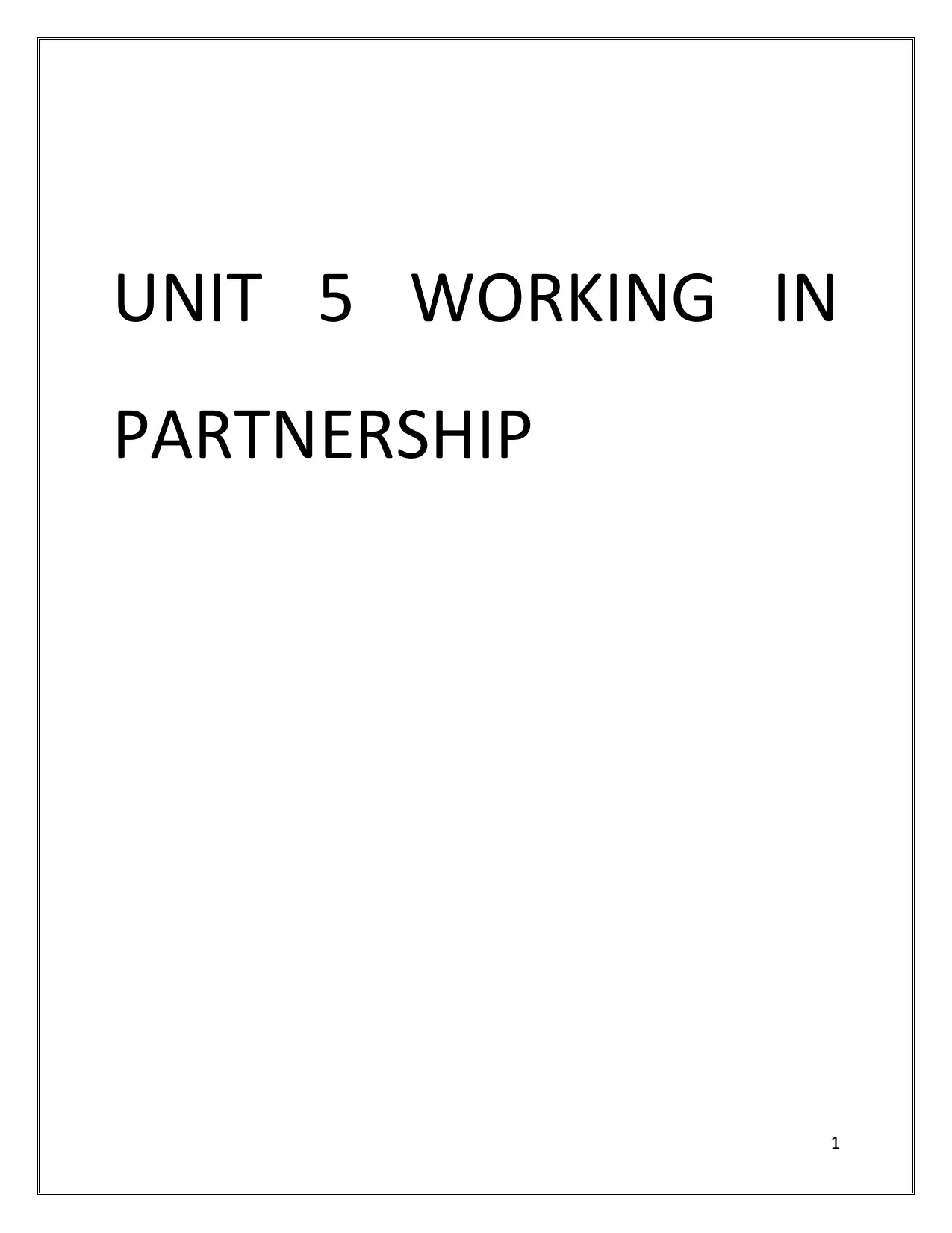
UNIT 5 WORKING IN
PARTNERSHIP
1
PARTNERSHIP
1
Paraphrase This Document
Need a fresh take? Get an instant paraphrase of this document with our AI Paraphraser
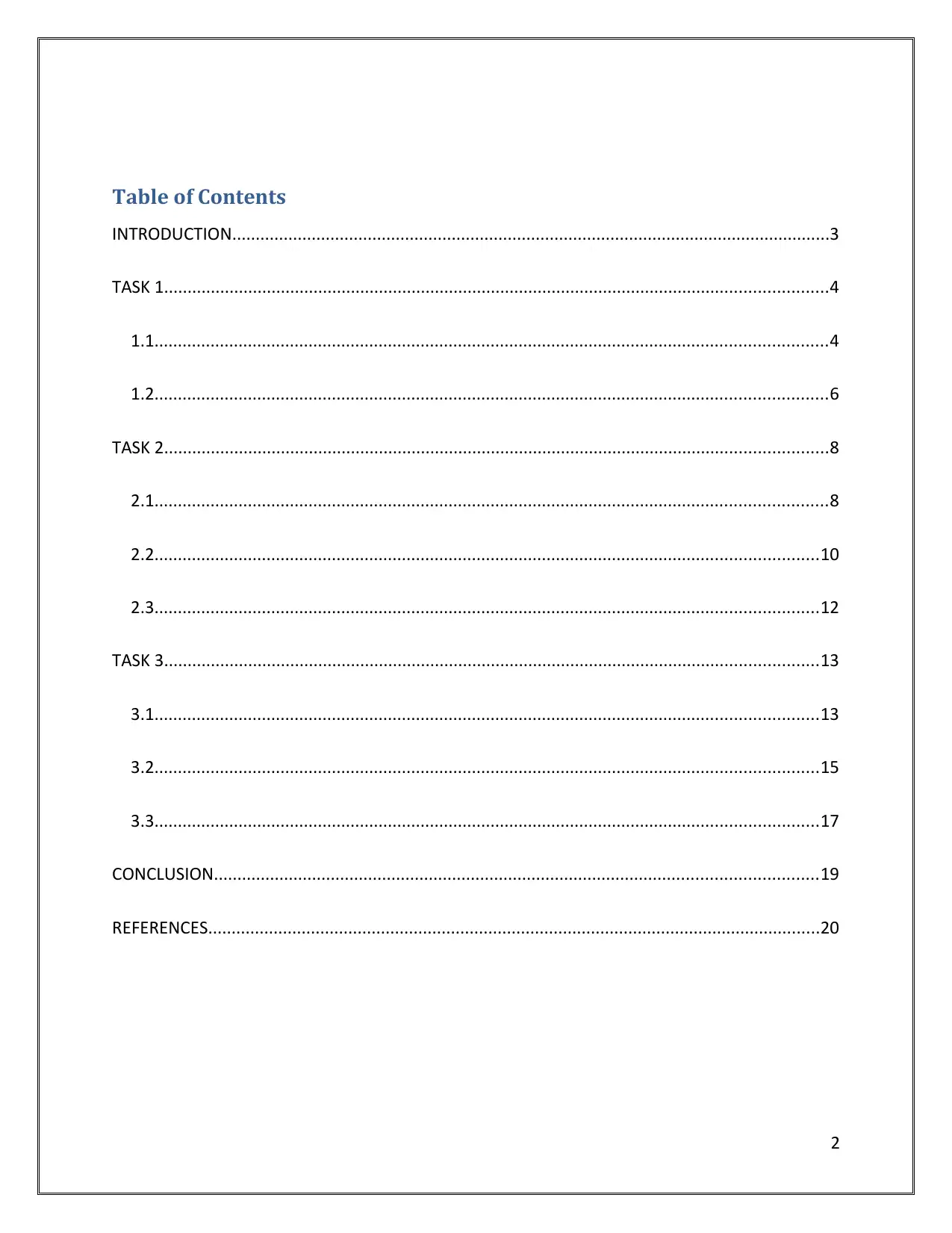
Table of Contents
INTRODUCTION................................................................................................................................3
TASK 1..............................................................................................................................................4
1.1................................................................................................................................................4
1.2................................................................................................................................................6
TASK 2..............................................................................................................................................8
2.1................................................................................................................................................8
2.2..............................................................................................................................................10
2.3..............................................................................................................................................12
TASK 3............................................................................................................................................13
3.1..............................................................................................................................................13
3.2..............................................................................................................................................15
3.3..............................................................................................................................................17
CONCLUSION.................................................................................................................................19
REFERENCES...................................................................................................................................20
2
INTRODUCTION................................................................................................................................3
TASK 1..............................................................................................................................................4
1.1................................................................................................................................................4
1.2................................................................................................................................................6
TASK 2..............................................................................................................................................8
2.1................................................................................................................................................8
2.2..............................................................................................................................................10
2.3..............................................................................................................................................12
TASK 3............................................................................................................................................13
3.1..............................................................................................................................................13
3.2..............................................................................................................................................15
3.3..............................................................................................................................................17
CONCLUSION.................................................................................................................................19
REFERENCES...................................................................................................................................20
2
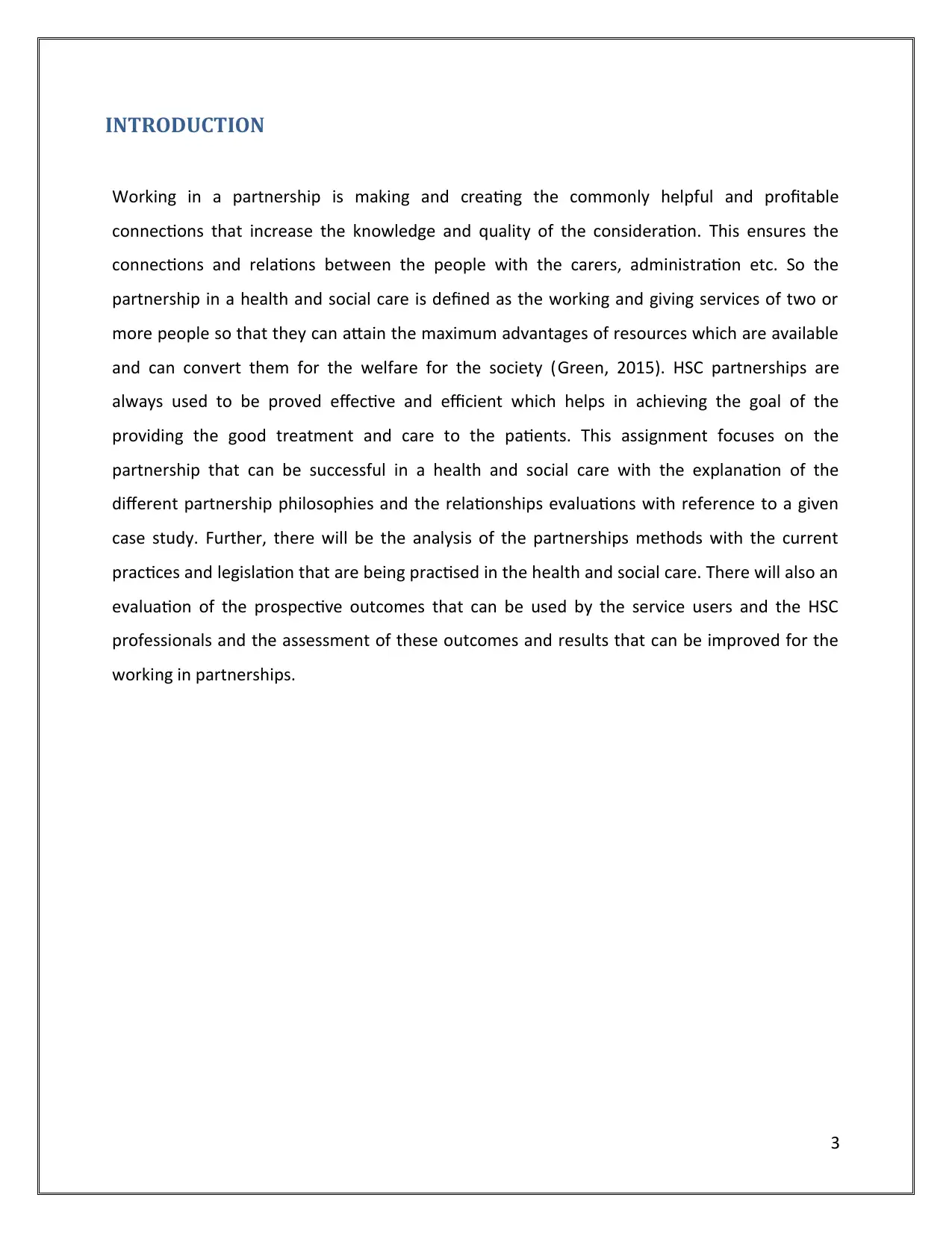
INTRODUCTION
Working in a partnership is making and creating the commonly helpful and profitable
connections that increase the knowledge and quality of the consideration. This ensures the
connections and relations between the people with the carers, administration etc. So the
partnership in a health and social care is defined as the working and giving services of two or
more people so that they can attain the maximum advantages of resources which are available
and can convert them for the welfare for the society (Green, 2015). HSC partnerships are
always used to be proved effective and efficient which helps in achieving the goal of the
providing the good treatment and care to the patients. This assignment focuses on the
partnership that can be successful in a health and social care with the explanation of the
different partnership philosophies and the relationships evaluations with reference to a given
case study. Further, there will be the analysis of the partnerships methods with the current
practices and legislation that are being practised in the health and social care. There will also an
evaluation of the prospective outcomes that can be used by the service users and the HSC
professionals and the assessment of these outcomes and results that can be improved for the
working in partnerships.
3
Working in a partnership is making and creating the commonly helpful and profitable
connections that increase the knowledge and quality of the consideration. This ensures the
connections and relations between the people with the carers, administration etc. So the
partnership in a health and social care is defined as the working and giving services of two or
more people so that they can attain the maximum advantages of resources which are available
and can convert them for the welfare for the society (Green, 2015). HSC partnerships are
always used to be proved effective and efficient which helps in achieving the goal of the
providing the good treatment and care to the patients. This assignment focuses on the
partnership that can be successful in a health and social care with the explanation of the
different partnership philosophies and the relationships evaluations with reference to a given
case study. Further, there will be the analysis of the partnerships methods with the current
practices and legislation that are being practised in the health and social care. There will also an
evaluation of the prospective outcomes that can be used by the service users and the HSC
professionals and the assessment of these outcomes and results that can be improved for the
working in partnerships.
3
⊘ This is a preview!⊘
Do you want full access?
Subscribe today to unlock all pages.

Trusted by 1+ million students worldwide
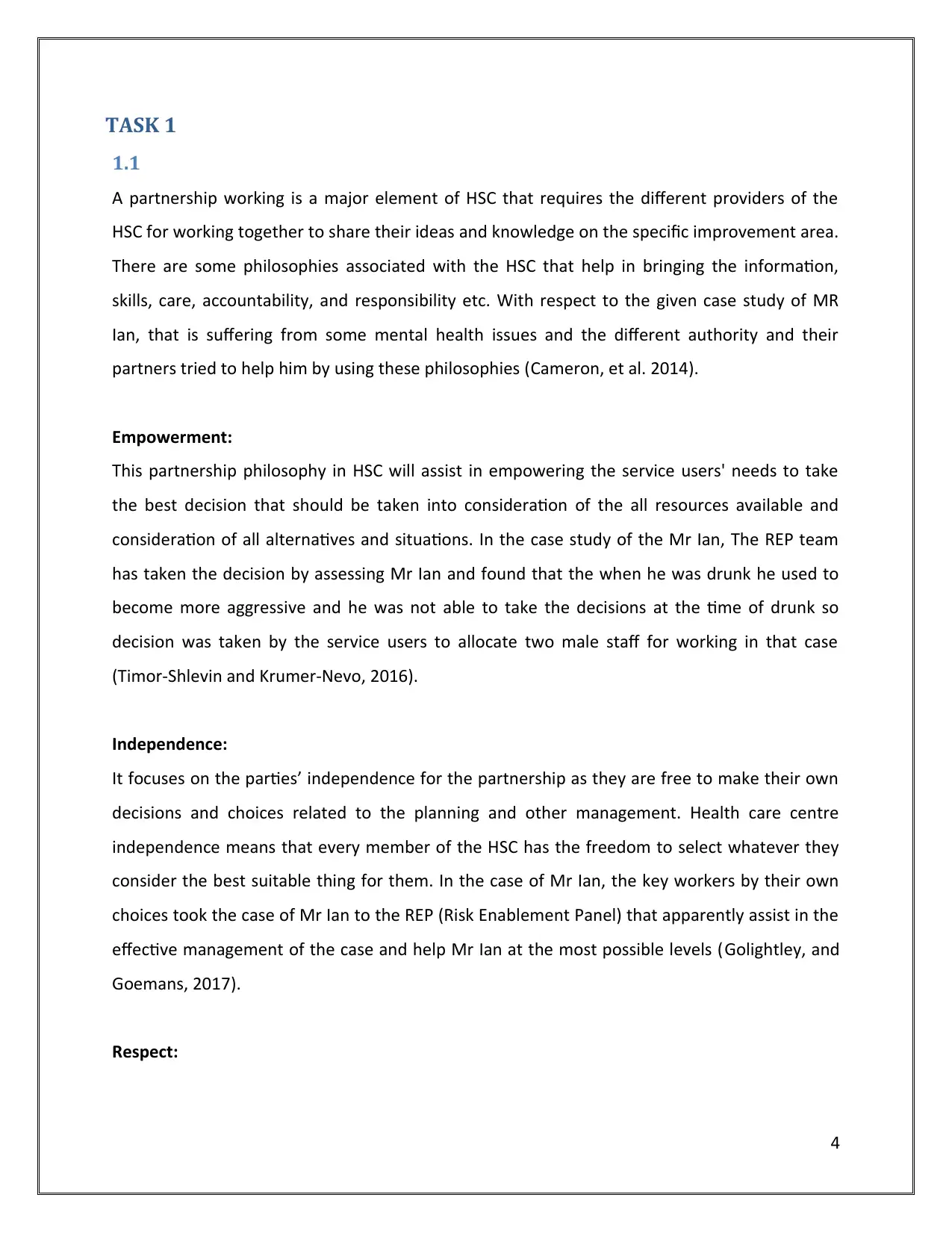
TASK 1
1.1
A partnership working is a major element of HSC that requires the different providers of the
HSC for working together to share their ideas and knowledge on the specific improvement area.
There are some philosophies associated with the HSC that help in bringing the information,
skills, care, accountability, and responsibility etc. With respect to the given case study of MR
Ian, that is suffering from some mental health issues and the different authority and their
partners tried to help him by using these philosophies (Cameron, et al. 2014).
Empowerment:
This partnership philosophy in HSC will assist in empowering the service users' needs to take
the best decision that should be taken into consideration of the all resources available and
consideration of all alternatives and situations. In the case study of the Mr Ian, The REP team
has taken the decision by assessing Mr Ian and found that the when he was drunk he used to
become more aggressive and he was not able to take the decisions at the time of drunk so
decision was taken by the service users to allocate two male staff for working in that case
(Timor‐Shlevin and Krumer‐Nevo, 2016).
Independence:
It focuses on the parties’ independence for the partnership as they are free to make their own
decisions and choices related to the planning and other management. Health care centre
independence means that every member of the HSC has the freedom to select whatever they
consider the best suitable thing for them. In the case of Mr Ian, the key workers by their own
choices took the case of Mr Ian to the REP (Risk Enablement Panel) that apparently assist in the
effective management of the case and help Mr Ian at the most possible levels (Golightley, and
Goemans, 2017).
Respect:
4
1.1
A partnership working is a major element of HSC that requires the different providers of the
HSC for working together to share their ideas and knowledge on the specific improvement area.
There are some philosophies associated with the HSC that help in bringing the information,
skills, care, accountability, and responsibility etc. With respect to the given case study of MR
Ian, that is suffering from some mental health issues and the different authority and their
partners tried to help him by using these philosophies (Cameron, et al. 2014).
Empowerment:
This partnership philosophy in HSC will assist in empowering the service users' needs to take
the best decision that should be taken into consideration of the all resources available and
consideration of all alternatives and situations. In the case study of the Mr Ian, The REP team
has taken the decision by assessing Mr Ian and found that the when he was drunk he used to
become more aggressive and he was not able to take the decisions at the time of drunk so
decision was taken by the service users to allocate two male staff for working in that case
(Timor‐Shlevin and Krumer‐Nevo, 2016).
Independence:
It focuses on the parties’ independence for the partnership as they are free to make their own
decisions and choices related to the planning and other management. Health care centre
independence means that every member of the HSC has the freedom to select whatever they
consider the best suitable thing for them. In the case of Mr Ian, the key workers by their own
choices took the case of Mr Ian to the REP (Risk Enablement Panel) that apparently assist in the
effective management of the case and help Mr Ian at the most possible levels (Golightley, and
Goemans, 2017).
Respect:
4
Paraphrase This Document
Need a fresh take? Get an instant paraphrase of this document with our AI Paraphraser
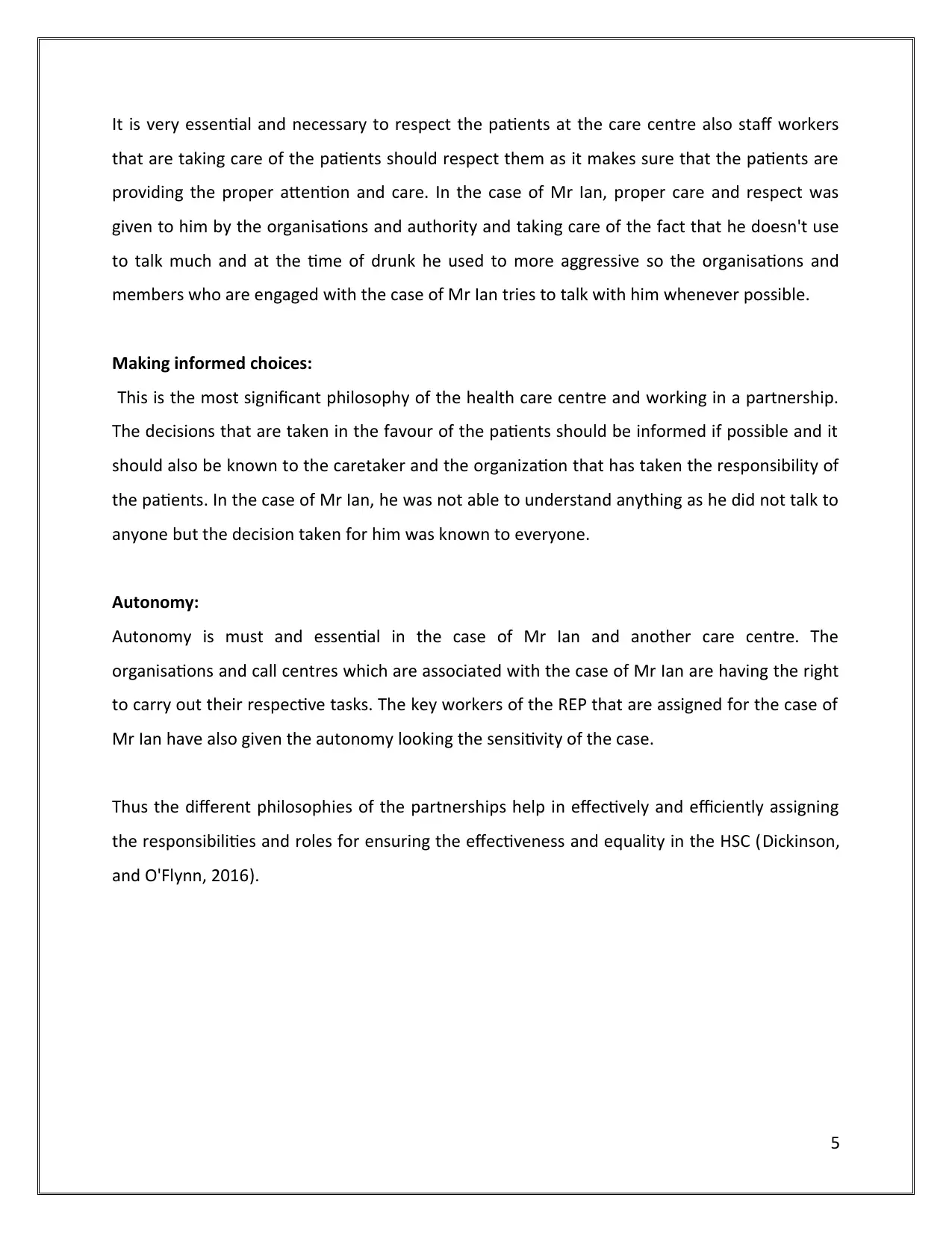
It is very essential and necessary to respect the patients at the care centre also staff workers
that are taking care of the patients should respect them as it makes sure that the patients are
providing the proper attention and care. In the case of Mr Ian, proper care and respect was
given to him by the organisations and authority and taking care of the fact that he doesn't use
to talk much and at the time of drunk he used to more aggressive so the organisations and
members who are engaged with the case of Mr Ian tries to talk with him whenever possible.
Making informed choices:
This is the most significant philosophy of the health care centre and working in a partnership.
The decisions that are taken in the favour of the patients should be informed if possible and it
should also be known to the caretaker and the organization that has taken the responsibility of
the patients. In the case of Mr Ian, he was not able to understand anything as he did not talk to
anyone but the decision taken for him was known to everyone.
Autonomy:
Autonomy is must and essential in the case of Mr Ian and another care centre. The
organisations and call centres which are associated with the case of Mr Ian are having the right
to carry out their respective tasks. The key workers of the REP that are assigned for the case of
Mr Ian have also given the autonomy looking the sensitivity of the case.
Thus the different philosophies of the partnerships help in effectively and efficiently assigning
the responsibilities and roles for ensuring the effectiveness and equality in the HSC (Dickinson,
and O'Flynn, 2016).
5
that are taking care of the patients should respect them as it makes sure that the patients are
providing the proper attention and care. In the case of Mr Ian, proper care and respect was
given to him by the organisations and authority and taking care of the fact that he doesn't use
to talk much and at the time of drunk he used to more aggressive so the organisations and
members who are engaged with the case of Mr Ian tries to talk with him whenever possible.
Making informed choices:
This is the most significant philosophy of the health care centre and working in a partnership.
The decisions that are taken in the favour of the patients should be informed if possible and it
should also be known to the caretaker and the organization that has taken the responsibility of
the patients. In the case of Mr Ian, he was not able to understand anything as he did not talk to
anyone but the decision taken for him was known to everyone.
Autonomy:
Autonomy is must and essential in the case of Mr Ian and another care centre. The
organisations and call centres which are associated with the case of Mr Ian are having the right
to carry out their respective tasks. The key workers of the REP that are assigned for the case of
Mr Ian have also given the autonomy looking the sensitivity of the case.
Thus the different philosophies of the partnerships help in effectively and efficiently assigning
the responsibilities and roles for ensuring the effectiveness and equality in the HSC (Dickinson,
and O'Flynn, 2016).
5
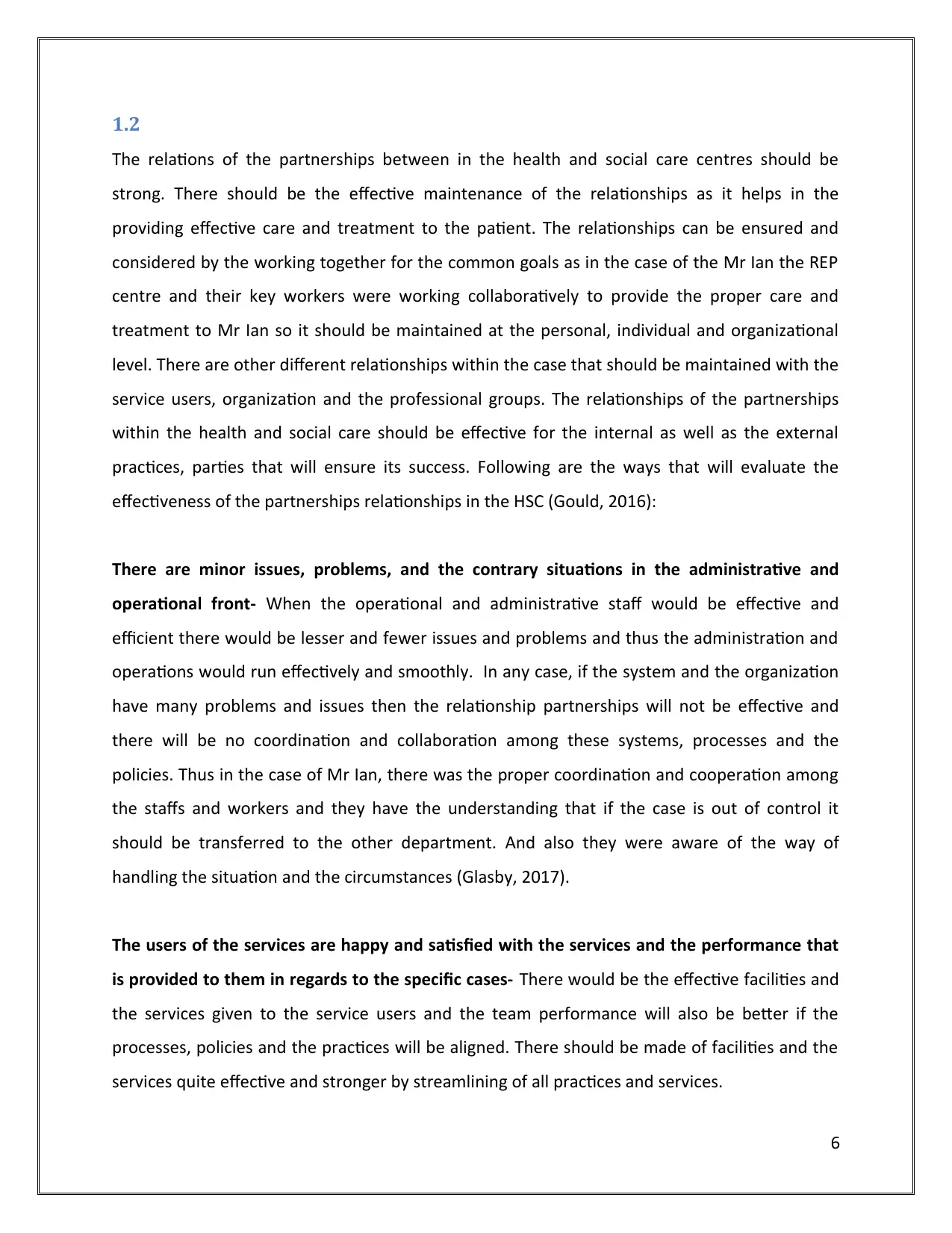
1.2
The relations of the partnerships between in the health and social care centres should be
strong. There should be the effective maintenance of the relationships as it helps in the
providing effective care and treatment to the patient. The relationships can be ensured and
considered by the working together for the common goals as in the case of the Mr Ian the REP
centre and their key workers were working collaboratively to provide the proper care and
treatment to Mr Ian so it should be maintained at the personal, individual and organizational
level. There are other different relationships within the case that should be maintained with the
service users, organization and the professional groups. The relationships of the partnerships
within the health and social care should be effective for the internal as well as the external
practices, parties that will ensure its success. Following are the ways that will evaluate the
effectiveness of the partnerships relationships in the HSC (Gould, 2016):
There are minor issues, problems, and the contrary situations in the administrative and
operational front- When the operational and administrative staff would be effective and
efficient there would be lesser and fewer issues and problems and thus the administration and
operations would run effectively and smoothly. In any case, if the system and the organization
have many problems and issues then the relationship partnerships will not be effective and
there will be no coordination and collaboration among these systems, processes and the
policies. Thus in the case of Mr Ian, there was the proper coordination and cooperation among
the staffs and workers and they have the understanding that if the case is out of control it
should be transferred to the other department. And also they were aware of the way of
handling the situation and the circumstances (Glasby, 2017).
The users of the services are happy and satisfied with the services and the performance that
is provided to them in regards to the specific cases- There would be the effective facilities and
the services given to the service users and the team performance will also be better if the
processes, policies and the practices will be aligned. There should be made of facilities and the
services quite effective and stronger by streamlining of all practices and services.
6
The relations of the partnerships between in the health and social care centres should be
strong. There should be the effective maintenance of the relationships as it helps in the
providing effective care and treatment to the patient. The relationships can be ensured and
considered by the working together for the common goals as in the case of the Mr Ian the REP
centre and their key workers were working collaboratively to provide the proper care and
treatment to Mr Ian so it should be maintained at the personal, individual and organizational
level. There are other different relationships within the case that should be maintained with the
service users, organization and the professional groups. The relationships of the partnerships
within the health and social care should be effective for the internal as well as the external
practices, parties that will ensure its success. Following are the ways that will evaluate the
effectiveness of the partnerships relationships in the HSC (Gould, 2016):
There are minor issues, problems, and the contrary situations in the administrative and
operational front- When the operational and administrative staff would be effective and
efficient there would be lesser and fewer issues and problems and thus the administration and
operations would run effectively and smoothly. In any case, if the system and the organization
have many problems and issues then the relationship partnerships will not be effective and
there will be no coordination and collaboration among these systems, processes and the
policies. Thus in the case of Mr Ian, there was the proper coordination and cooperation among
the staffs and workers and they have the understanding that if the case is out of control it
should be transferred to the other department. And also they were aware of the way of
handling the situation and the circumstances (Glasby, 2017).
The users of the services are happy and satisfied with the services and the performance that
is provided to them in regards to the specific cases- There would be the effective facilities and
the services given to the service users and the team performance will also be better if the
processes, policies and the practices will be aligned. There should be made of facilities and the
services quite effective and stronger by streamlining of all practices and services.
6
⊘ This is a preview!⊘
Do you want full access?
Subscribe today to unlock all pages.

Trusted by 1+ million students worldwide
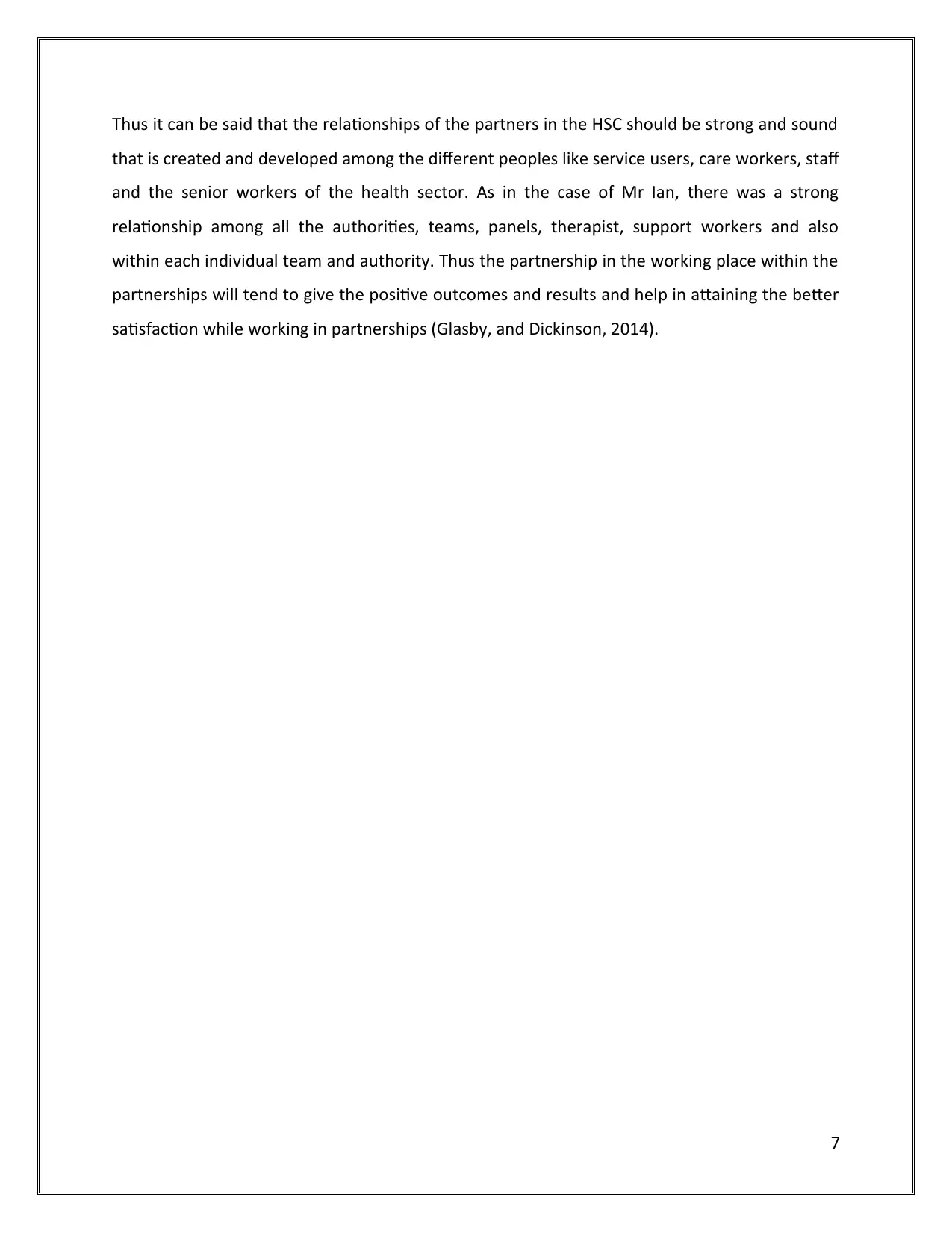
Thus it can be said that the relationships of the partners in the HSC should be strong and sound
that is created and developed among the different peoples like service users, care workers, staff
and the senior workers of the health sector. As in the case of Mr Ian, there was a strong
relationship among all the authorities, teams, panels, therapist, support workers and also
within each individual team and authority. Thus the partnership in the working place within the
partnerships will tend to give the positive outcomes and results and help in attaining the better
satisfaction while working in partnerships (Glasby, and Dickinson, 2014).
7
that is created and developed among the different peoples like service users, care workers, staff
and the senior workers of the health sector. As in the case of Mr Ian, there was a strong
relationship among all the authorities, teams, panels, therapist, support workers and also
within each individual team and authority. Thus the partnership in the working place within the
partnerships will tend to give the positive outcomes and results and help in attaining the better
satisfaction while working in partnerships (Glasby, and Dickinson, 2014).
7
Paraphrase This Document
Need a fresh take? Get an instant paraphrase of this document with our AI Paraphraser
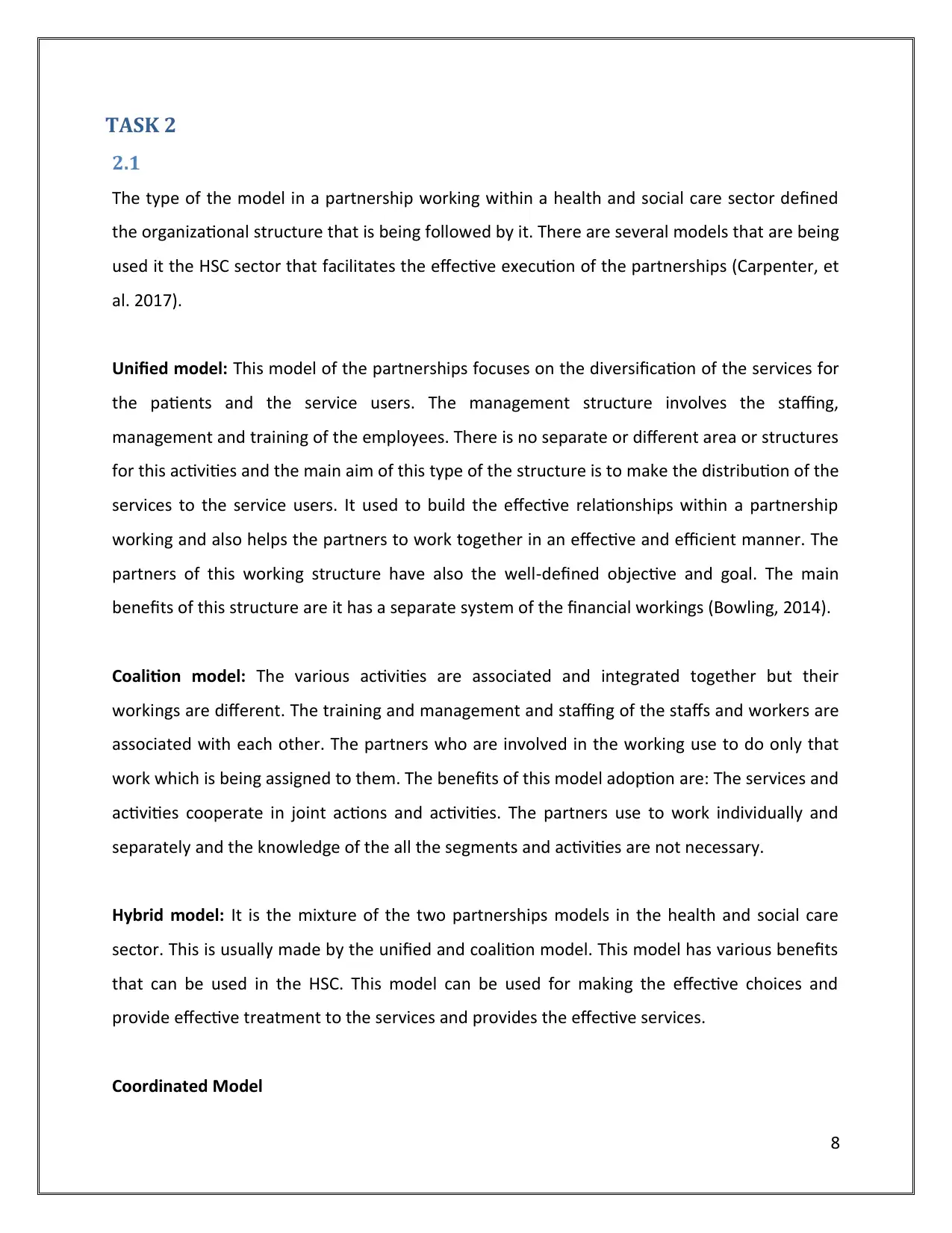
TASK 2
2.1
The type of the model in a partnership working within a health and social care sector defined
the organizational structure that is being followed by it. There are several models that are being
used it the HSC sector that facilitates the effective execution of the partnerships (Carpenter, et
al. 2017).
Unified model: This model of the partnerships focuses on the diversification of the services for
the patients and the service users. The management structure involves the staffing,
management and training of the employees. There is no separate or different area or structures
for this activities and the main aim of this type of the structure is to make the distribution of the
services to the service users. It used to build the effective relationships within a partnership
working and also helps the partners to work together in an effective and efficient manner. The
partners of this working structure have also the well‐defined objective and goal. The main
benefits of this structure are it has a separate system of the financial workings (Bowling, 2014).
Coalition model: The various activities are associated and integrated together but their
workings are different. The training and management and staffing of the staffs and workers are
associated with each other. The partners who are involved in the working use to do only that
work which is being assigned to them. The benefits of this model adoption are: The services and
activities cooperate in joint actions and activities. The partners use to work individually and
separately and the knowledge of the all the segments and activities are not necessary.
Hybrid model: It is the mixture of the two partnerships models in the health and social care
sector. This is usually made by the unified and coalition model. This model has various benefits
that can be used in the HSC. This model can be used for making the effective choices and
provide effective treatment to the services and provides the effective services.
Coordinated Model
8
2.1
The type of the model in a partnership working within a health and social care sector defined
the organizational structure that is being followed by it. There are several models that are being
used it the HSC sector that facilitates the effective execution of the partnerships (Carpenter, et
al. 2017).
Unified model: This model of the partnerships focuses on the diversification of the services for
the patients and the service users. The management structure involves the staffing,
management and training of the employees. There is no separate or different area or structures
for this activities and the main aim of this type of the structure is to make the distribution of the
services to the service users. It used to build the effective relationships within a partnership
working and also helps the partners to work together in an effective and efficient manner. The
partners of this working structure have also the well‐defined objective and goal. The main
benefits of this structure are it has a separate system of the financial workings (Bowling, 2014).
Coalition model: The various activities are associated and integrated together but their
workings are different. The training and management and staffing of the staffs and workers are
associated with each other. The partners who are involved in the working use to do only that
work which is being assigned to them. The benefits of this model adoption are: The services and
activities cooperate in joint actions and activities. The partners use to work individually and
separately and the knowledge of the all the segments and activities are not necessary.
Hybrid model: It is the mixture of the two partnerships models in the health and social care
sector. This is usually made by the unified and coalition model. This model has various benefits
that can be used in the HSC. This model can be used for making the effective choices and
provide effective treatment to the services and provides the effective services.
Coordinated Model
8
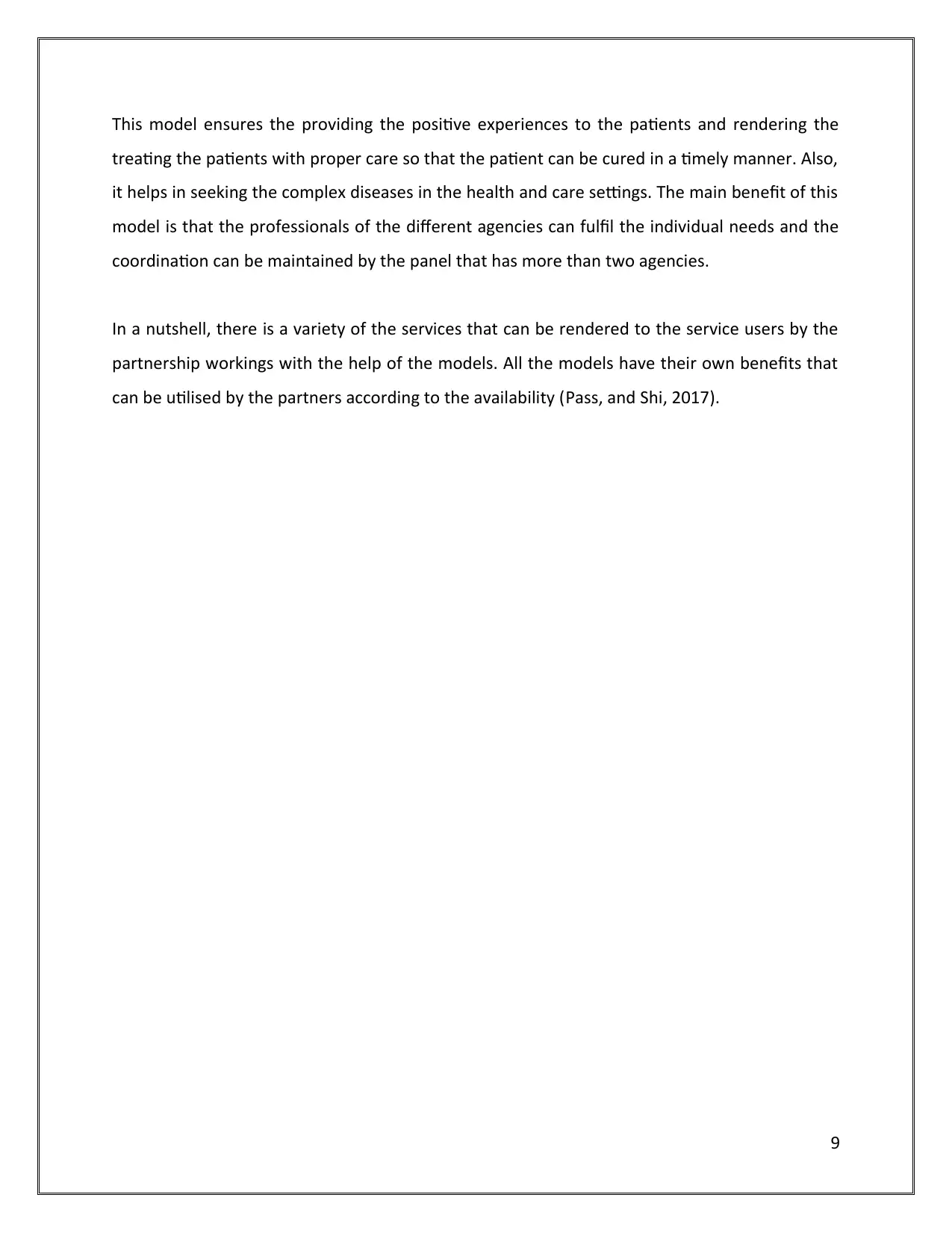
This model ensures the providing the positive experiences to the patients and rendering the
treating the patients with proper care so that the patient can be cured in a timely manner. Also,
it helps in seeking the complex diseases in the health and care settings. The main benefit of this
model is that the professionals of the different agencies can fulfil the individual needs and the
coordination can be maintained by the panel that has more than two agencies.
In a nutshell, there is a variety of the services that can be rendered to the service users by the
partnership workings with the help of the models. All the models have their own benefits that
can be utilised by the partners according to the availability (Pass, and Shi, 2017).
9
treating the patients with proper care so that the patient can be cured in a timely manner. Also,
it helps in seeking the complex diseases in the health and care settings. The main benefit of this
model is that the professionals of the different agencies can fulfil the individual needs and the
coordination can be maintained by the panel that has more than two agencies.
In a nutshell, there is a variety of the services that can be rendered to the service users by the
partnership workings with the help of the models. All the models have their own benefits that
can be utilised by the partners according to the availability (Pass, and Shi, 2017).
9
⊘ This is a preview!⊘
Do you want full access?
Subscribe today to unlock all pages.

Trusted by 1+ million students worldwide
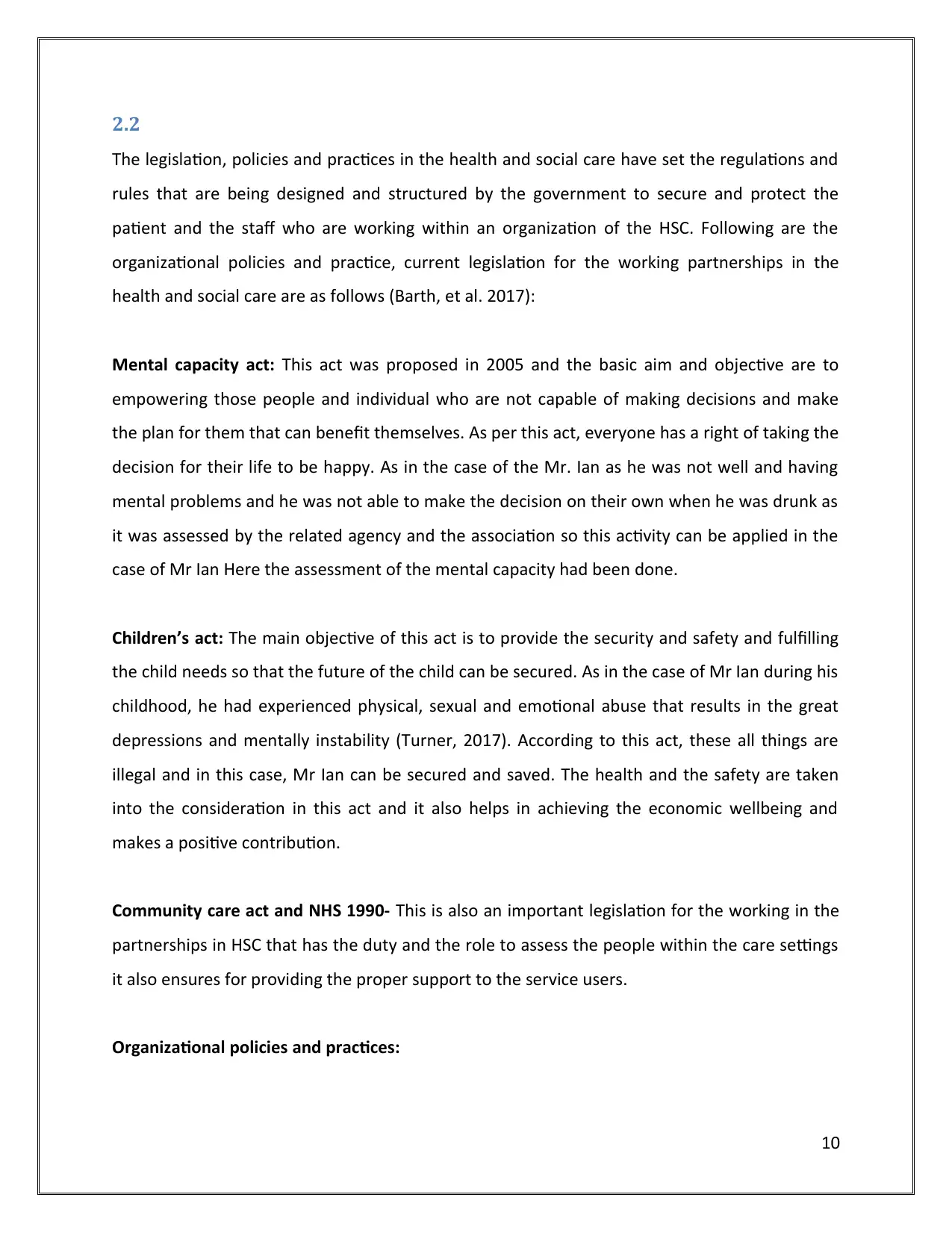
2.2
The legislation, policies and practices in the health and social care have set the regulations and
rules that are being designed and structured by the government to secure and protect the
patient and the staff who are working within an organization of the HSC. Following are the
organizational policies and practice, current legislation for the working partnerships in the
health and social care are as follows (Barth, et al. 2017):
Mental capacity act: This act was proposed in 2005 and the basic aim and objective are to
empowering those people and individual who are not capable of making decisions and make
the plan for them that can benefit themselves. As per this act, everyone has a right of taking the
decision for their life to be happy. As in the case of the Mr. Ian as he was not well and having
mental problems and he was not able to make the decision on their own when he was drunk as
it was assessed by the related agency and the association so this activity can be applied in the
case of Mr Ian Here the assessment of the mental capacity had been done.
Children’s act: The main objective of this act is to provide the security and safety and fulfilling
the child needs so that the future of the child can be secured. As in the case of Mr Ian during his
childhood, he had experienced physical, sexual and emotional abuse that results in the great
depressions and mentally instability (Turner, 2017). According to this act, these all things are
illegal and in this case, Mr Ian can be secured and saved. The health and the safety are taken
into the consideration in this act and it also helps in achieving the economic wellbeing and
makes a positive contribution.
Community care act and NHS 1990- This is also an important legislation for the working in the
partnerships in HSC that has the duty and the role to assess the people within the care settings
it also ensures for providing the proper support to the service users.
Organizational policies and practices:
10
The legislation, policies and practices in the health and social care have set the regulations and
rules that are being designed and structured by the government to secure and protect the
patient and the staff who are working within an organization of the HSC. Following are the
organizational policies and practice, current legislation for the working partnerships in the
health and social care are as follows (Barth, et al. 2017):
Mental capacity act: This act was proposed in 2005 and the basic aim and objective are to
empowering those people and individual who are not capable of making decisions and make
the plan for them that can benefit themselves. As per this act, everyone has a right of taking the
decision for their life to be happy. As in the case of the Mr. Ian as he was not well and having
mental problems and he was not able to make the decision on their own when he was drunk as
it was assessed by the related agency and the association so this activity can be applied in the
case of Mr Ian Here the assessment of the mental capacity had been done.
Children’s act: The main objective of this act is to provide the security and safety and fulfilling
the child needs so that the future of the child can be secured. As in the case of Mr Ian during his
childhood, he had experienced physical, sexual and emotional abuse that results in the great
depressions and mentally instability (Turner, 2017). According to this act, these all things are
illegal and in this case, Mr Ian can be secured and saved. The health and the safety are taken
into the consideration in this act and it also helps in achieving the economic wellbeing and
makes a positive contribution.
Community care act and NHS 1990- This is also an important legislation for the working in the
partnerships in HSC that has the duty and the role to assess the people within the care settings
it also ensures for providing the proper support to the service users.
Organizational policies and practices:
10
Paraphrase This Document
Need a fresh take? Get an instant paraphrase of this document with our AI Paraphraser
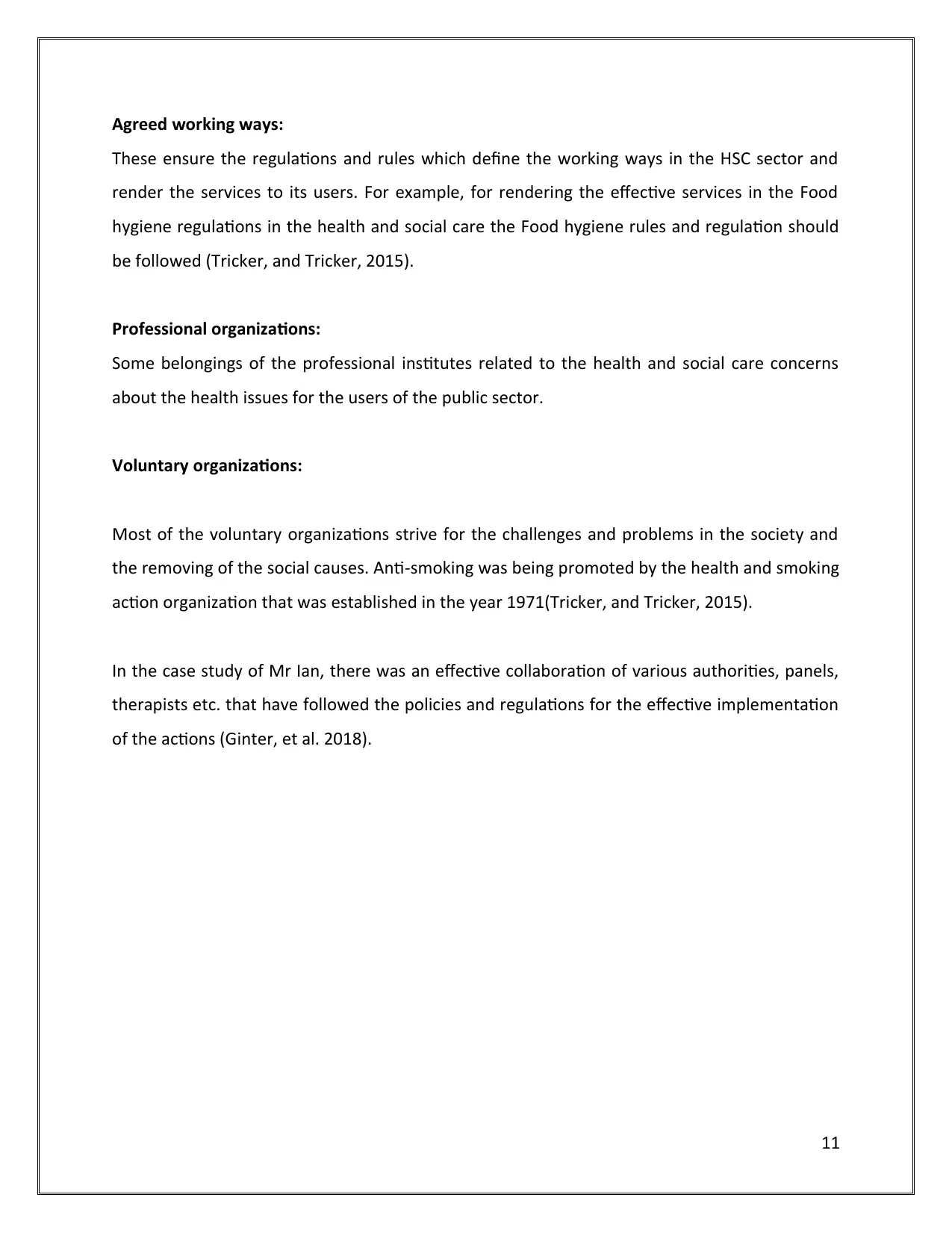
Agreed working ways:
These ensure the regulations and rules which define the working ways in the HSC sector and
render the services to its users. For example, for rendering the effective services in the Food
hygiene regulations in the health and social care the Food hygiene rules and regulation should
be followed (Tricker, and Tricker, 2015).
Professional organizations:
Some belongings of the professional institutes related to the health and social care concerns
about the health issues for the users of the public sector.
Voluntary organizations:
Most of the voluntary organizations strive for the challenges and problems in the society and
the removing of the social causes. Anti‐smoking was being promoted by the health and smoking
action organization that was established in the year 1971(Tricker, and Tricker, 2015).
In the case study of Mr Ian, there was an effective collaboration of various authorities, panels,
therapists etc. that have followed the policies and regulations for the effective implementation
of the actions (Ginter, et al. 2018).
11
These ensure the regulations and rules which define the working ways in the HSC sector and
render the services to its users. For example, for rendering the effective services in the Food
hygiene regulations in the health and social care the Food hygiene rules and regulation should
be followed (Tricker, and Tricker, 2015).
Professional organizations:
Some belongings of the professional institutes related to the health and social care concerns
about the health issues for the users of the public sector.
Voluntary organizations:
Most of the voluntary organizations strive for the challenges and problems in the society and
the removing of the social causes. Anti‐smoking was being promoted by the health and smoking
action organization that was established in the year 1971(Tricker, and Tricker, 2015).
In the case study of Mr Ian, there was an effective collaboration of various authorities, panels,
therapists etc. that have followed the policies and regulations for the effective implementation
of the actions (Ginter, et al. 2018).
11
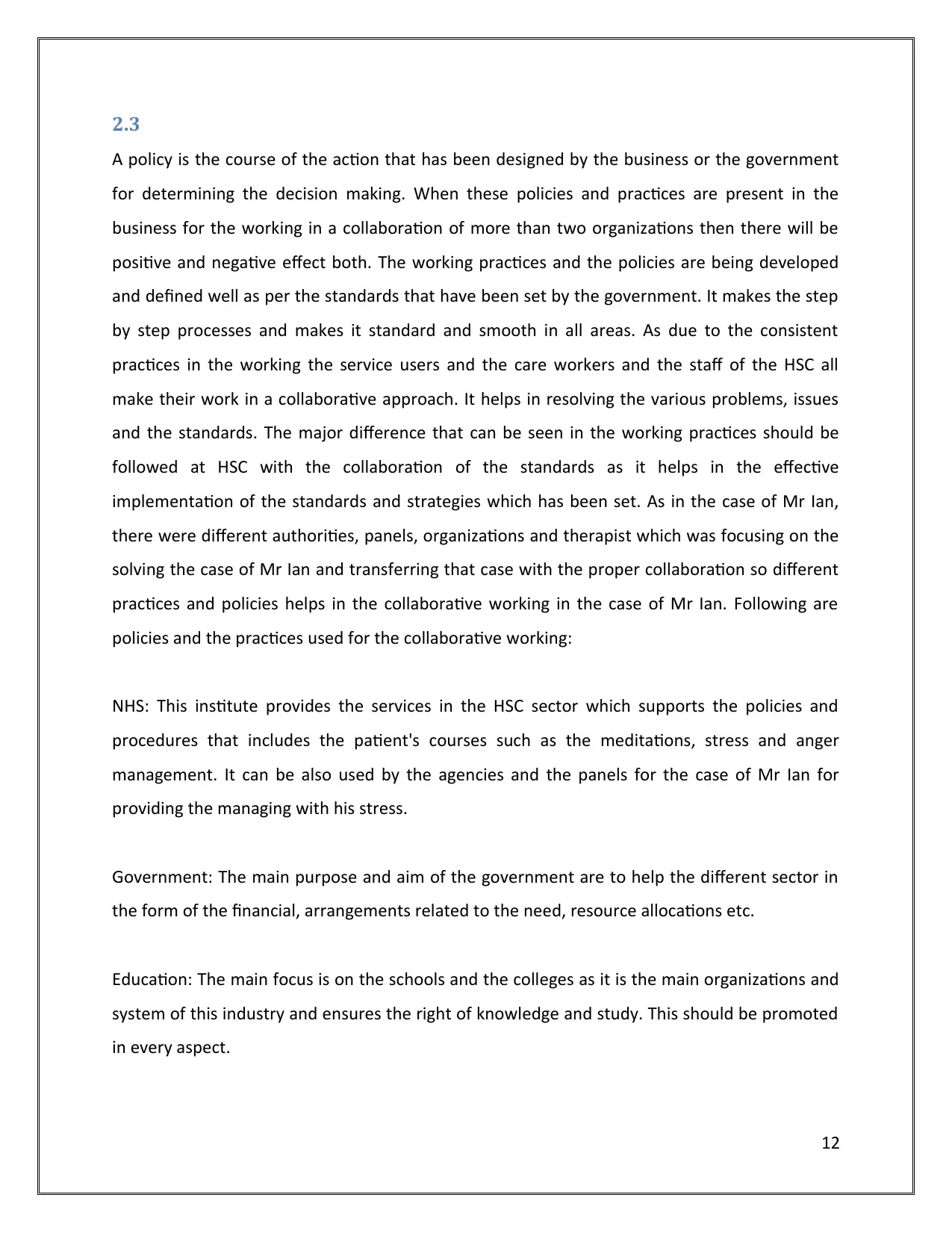
2.3
A policy is the course of the action that has been designed by the business or the government
for determining the decision making. When these policies and practices are present in the
business for the working in a collaboration of more than two organizations then there will be
positive and negative effect both. The working practices and the policies are being developed
and defined well as per the standards that have been set by the government. It makes the step
by step processes and makes it standard and smooth in all areas. As due to the consistent
practices in the working the service users and the care workers and the staff of the HSC all
make their work in a collaborative approach. It helps in resolving the various problems, issues
and the standards. The major difference that can be seen in the working practices should be
followed at HSC with the collaboration of the standards as it helps in the effective
implementation of the standards and strategies which has been set. As in the case of Mr Ian,
there were different authorities, panels, organizations and therapist which was focusing on the
solving the case of Mr Ian and transferring that case with the proper collaboration so different
practices and policies helps in the collaborative working in the case of Mr Ian. Following are
policies and the practices used for the collaborative working:
NHS: This institute provides the services in the HSC sector which supports the policies and
procedures that includes the patient's courses such as the meditations, stress and anger
management. It can be also used by the agencies and the panels for the case of Mr Ian for
providing the managing with his stress.
Government: The main purpose and aim of the government are to help the different sector in
the form of the financial, arrangements related to the need, resource allocations etc.
Education: The main focus is on the schools and the colleges as it is the main organizations and
system of this industry and ensures the right of knowledge and study. This should be promoted
in every aspect.
12
A policy is the course of the action that has been designed by the business or the government
for determining the decision making. When these policies and practices are present in the
business for the working in a collaboration of more than two organizations then there will be
positive and negative effect both. The working practices and the policies are being developed
and defined well as per the standards that have been set by the government. It makes the step
by step processes and makes it standard and smooth in all areas. As due to the consistent
practices in the working the service users and the care workers and the staff of the HSC all
make their work in a collaborative approach. It helps in resolving the various problems, issues
and the standards. The major difference that can be seen in the working practices should be
followed at HSC with the collaboration of the standards as it helps in the effective
implementation of the standards and strategies which has been set. As in the case of Mr Ian,
there were different authorities, panels, organizations and therapist which was focusing on the
solving the case of Mr Ian and transferring that case with the proper collaboration so different
practices and policies helps in the collaborative working in the case of Mr Ian. Following are
policies and the practices used for the collaborative working:
NHS: This institute provides the services in the HSC sector which supports the policies and
procedures that includes the patient's courses such as the meditations, stress and anger
management. It can be also used by the agencies and the panels for the case of Mr Ian for
providing the managing with his stress.
Government: The main purpose and aim of the government are to help the different sector in
the form of the financial, arrangements related to the need, resource allocations etc.
Education: The main focus is on the schools and the colleges as it is the main organizations and
system of this industry and ensures the right of knowledge and study. This should be promoted
in every aspect.
12
⊘ This is a preview!⊘
Do you want full access?
Subscribe today to unlock all pages.

Trusted by 1+ million students worldwide
1 out of 21
Related Documents
Your All-in-One AI-Powered Toolkit for Academic Success.
+13062052269
info@desklib.com
Available 24*7 on WhatsApp / Email
![[object Object]](/_next/static/media/star-bottom.7253800d.svg)
Unlock your academic potential
Copyright © 2020–2025 A2Z Services. All Rights Reserved. Developed and managed by ZUCOL.




